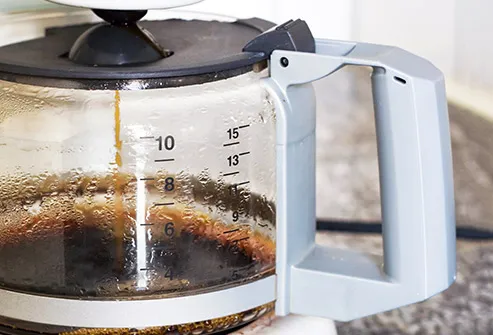
SLIDESHOW
Products Surprisingly High in Caffeine ( courtecy;- webMD )
Too much can make you anxious, nervous, or jittery. Find out which foods, beverages, and medications contain caffeine.
How Much Caffeine Is in That?
couple walking holding coffee cups
1/15
Why Does It Matter?
Caffeine can affect you in many ways. It can:
Boost energy, memory, and athletic performance
Ease headaches
Help prevent constipation and type 2 diabetes
Protect against brain diseases like Parkinson’s and Alzheimer’s
But too much can make you anxious, nervous, or jittery. It can affect sleep, digestion, blood pressure, heart rate, and heart rhythm. And it can damage a child's developing heart, blood vessels, and nervous system.
green tea
1/15
Green Tea
Serving size: 8 ounces
Caffeine: About 28 milligrams
Some people think this is an herbal tea with no caffeine. It’s actually made from the same leaves as black tea (the Camellia sinensis bush). It generally does have a bit less caffeine.
cup of hot tea
1/15
Black Tea
Serving size: 8 ounces
Caffeine: About 47 milligrams
Skip your regular morning coffee and you may get groggy, tired, irritable, and even sick. If you want to cut back, do it slowly. That'll give your body a chance to get used to it. A cup of tea in the morning instead of coffee may be a good place to start. At most, tea usually has half the caffeine of coffee.
sweet tea
1/15
Iced Tea
Serving size: 8 ounces
Caffeine: 25-48 milligrams
The size here is the same as the other teas. But keep in mind that it’s often sold in larger -- sometimes much larger -- servings. That could mean more than 100 milligrams of caffeine.
brewsing coffee
1/15
Brewed Coffee
Serving size: 8 ounces
Caffeine: 130-180 milligrams
For some retailers, 12 ounces is their smallest size. You can cut down how much caffeine you have by sticking to 8 ounces. Pour some out, if necessary. Of course, the stronger you make your coffee, the more caffeine it has.
cup of coffee
1/15
Espresso
Serving size: 2 ounces
Caffeine: About 126 milligrams
Many espresso-based drinks at your local coffee shop (cappuccinos, lattes, macchiatos) use this 2-ounce “double shot” as a base. A 1-ounce “single” shot would have about half that (about 63 milligrams).
coffee pot
1/15
Decaf Coffee
Serving size: 8 ounces
Caffeine: 2-15 milligrams
There are different methods for getting rid of caffeine in tea and coffee. The amount left depends on what you start with and how you get rid of it. U.S. government regulations require 97% of caffeine to be removed from coffee to call it “decaffeinated.”
soda
1/15
Soda
Serving size: 12 ounces
Caffeine: 34-54 milligrams
This range is for both diet and regular sodas that have caffeine. Usually, those that have none have “caffeine-free” on their label.
drink can
1/15
Energy Drinks
Serving size: 16 ounces
Caffeine: 140 to 350 milligrams
Ingredients like guarana can hide extra caffeine. The sugar or artificial sweeteners can make it easy to drink too much.
gum in hand
1/15
Caffeinated Gum
Serving size: 1 piece
Caffeine: 20-100 milligrams
It’s a good idea to do your homework on this. The range can be large and, like energy drinks, there can be hidden caffeine in ingredients like guarana. After meeting with the FDA, Wrigley, a major U.S. gum maker, decided not to sell gum with caffeine because of health concerns.
dark chocolate squares
1/15
Dark Chocolate
Serving Size: 1 ounce
Caffeine: About 23 milligrams
Because caffeine occurs naturally in chocolate, the FDA doesn't require makers to list how much it has, so it's tough to know. It’s not too much if you stick to one serving, which is about a third of a typical dark chocolate bar. More than that and the numbers can start to add up.
pills from bottle
1/15
Over-the-Counter Pain Relievers
Dose: 2 tablets
Caffeine: 130 milligrams
Some of these combine aspirin, acetaminophen, or both with caffeine. Though they can work well on your headache, they also add to your total daily amount, so you may need to cut back elsewhere.
white powder
1/15
Powdered Caffeine
Dose: Not recommended at any dose
Caffeine: 1 teaspoon = about 28 cups of coffee
The FDA knows of at least two deaths from this stuff and recommends you avoid it. You can’t measure safe amounts accurately with typical kitchen equipment. See a doctor if you think you've taken too much, start to vomit, or notice your heart beating too quickly or in an odd rhythm.
woman sipping coffee
1/15
How Much Is Too Much?
Different people can handle different amounts. But there's a limit to what you should have every day, even if it doesn’t bother you. Up to about 400 milligrams a day is usually OK for adults as part of a healthy diet. Once you hit 600 a day, you’re probably getting too much.
Sources | Medically Reviewed on 12/03/2017
This tool does not provide medical advice.
মন্তব্যসমূহ
একটি মন্তব্য পোস্ট করুন